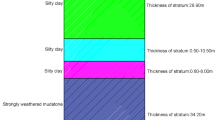Conclusions
-
1.
The C-629 hydrovibration installation achieves additional compaction of structurally stronger in situ sands and those with a distubbed structure, up to a maximumattainable under the industrlat conditions (bulk weight of the skeleton, λ-1.65–1.76 g/cm3; relative density D=0.6–0.8). Compaction is atchieved in 1–2 lowerings of the hydrovibrator.
-
2.
A significant effect is achieved in compaction down to 5 m. Ground compaction to greater dephths (to 10 m) tumed out to be difficult under the industrial conditions. With the tooldonger than 5 m, a slight slant of the vibrator in the movable clastic sleeve leads to a wedging-in of the hydrovibrator, to an excessive load on the electricmotor, and to frequent stoppage.
-
3.
Deep hydrovibration compaction in the presence of a high water table is three times faster than the other mechanical operations
-
4.
Deep compaction of sandy ground with the hydrovibrator is recommended for an extensive use in construction practice. Further improvements are necessary in the technique of compaction and in the hydrovibrator installation design.
Similar content being viewed by others
Literature Cited
G. I. Goretskii, “The Shevchenko glacial outwash suite along the middle Dnieper,” Doklady Akad. Nauk SSSR, 136 (1961).
S. V. Kukhtii, “Engineering geological conditions of Kanew HES construction,” Gidrotekh, Stroitel, No. 8 (1966).
“Mechanized Compactionof Ground Soils in Construction,” Proceedings of the Conference, Gosstroiizdat (1968)
D. D. Barkan, Application of Vibrations in Construction Foundation, Stroiizdat (1943).
D. D. Barkan, Vibration Technique in Construction, Gosströöcdat (1959).
N. N. Maslov, Stability Conditions for Water-Saturateds Sonds Gosénergoizdat (1959).
N. I. Gubina and A. M. Chernukhin, “Application of the C-629 hydrovibration installation in sand compaction in compartments of joint supports for the HES bilildiog, Gidrotekh. Stroitel. No. 2 (1965).
N. M. Gersevanov, Principles of Ground Mass Dynamics ONTI (1937).
P. L. Ivanov, Liquefaction of Sandy Soils, Gosénerrgoicdat (1982).
V. A. Durante, Study of Sand Density by Deep Sounding, Trudy Soveshchaniya po Inzhenerno-Gelogich. Svoistvam Gornykh Porod i Metodam ikh Izucheniya, Vol. 1,1 Akad. Nauk SSSR (1956).
Additional information
Translated from Gidrotekhnicheskoe Stroitel’stvo, No. 4, pp. 3–6, April, 1969.
Rights and permissions
About this article
Cite this article
Kukhtii, S.V., Sincha, V.M. Compaction of sandy founda tion for the Kanev hydroelectric station by the C-629 hydrovibrator. Hydrotechnical Construction 3, 299–303 (1969). https://doi.org/10.1007/BF02378150
Issue Date:
DOI: https://doi.org/10.1007/BF02378150




